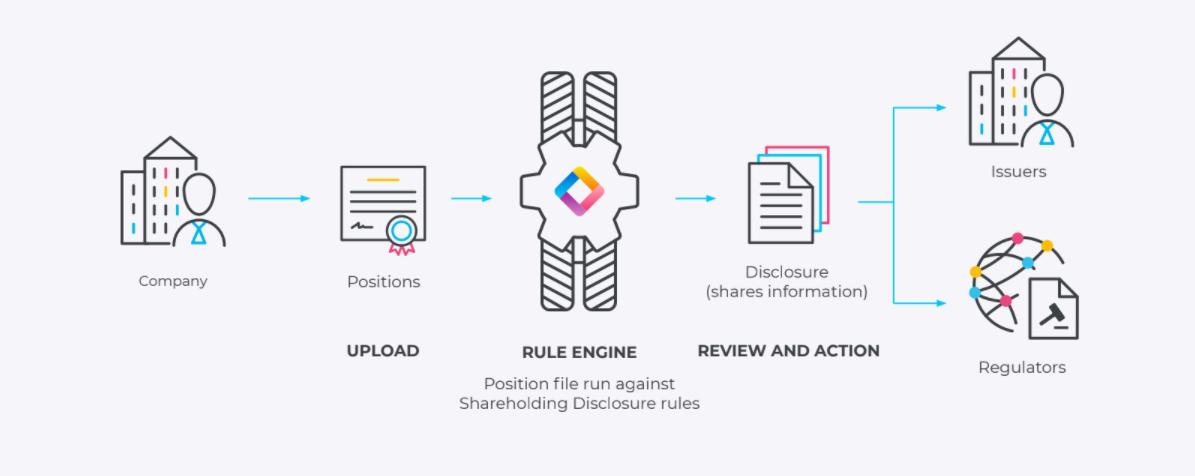For years, shareholding disclosure calculations have been done manually by compliance professionals.
Admittedly, most of these professionals are armed with traditional software such as Excel and therefore the risk of making an arithmetic error is low. However, we must not underestimate the risk of administrative errors. Here, we will use the Japanese shareholding regime to highlight some of the potential pitfalls of which a compliance professional should be aware.
Swinging Thresholds
Out of the 90+ jurisdictions that we cover, 20 jurisdictions have what we call a “swinging threshold” requirement. This means that in addition to the fixed percentage thresholds (eg. 5%, 10%), a disclosure obligation will also arise when a shareholding increases or decreases by a small amount (eg. 1% in Japan) from the previously disclosed value. This greatly increases the complexity of the monitoring requirement because it is no longer sufficient to only look out for the crossing of those fixed thresholds. Suddenly, a compliance professional goes from dealing with a handful of thresholds to an unmanageable number of disclosure scenarios.
Sure, some of you may try to deal with swinging thresholds using an Excel formula such as (=IF(ABS(A2-B2)>=C2, "Disclose", "Do Nothing"). Indeed, the ABS function in Excel together with an IF statement seems like a viable option because it allows users to calculate the absolute percentage movement. However, this logic will likely lead you to the first administrative trap of which to beware.
As mentioned, in Japan, a movement of 1% or more from the previously disclosed shareholding will trigger a disclosure obligation.
Does it follow that a shareholding movement from 6.357% to 7.429% in Japan will definitely trigger a disclosure obligation?
Not necessarily, because the last disclosed shareholding has not been specified here. The last disclosed shareholding could be 7.169%. In which case, the movement is still less than 1% and no disclosure is required. As far as we are aware, most commercially-available software on the market does not provide an easy way to store and anchor last disclosed values, let alone run calculations on them.
Joint Holder Requirement
Being able to handle a plain ‘vanilla’ swinging threshold will not be sufficient to ensure compliance in Japan. The “joint holder” requirement is an extra layer of complexity built on top of the swinging threshold. It stipulates that the swinging threshold must apply to not just the top entity in a corporate structure but also to related subsidiary entities! Any movement of 1% or more by these subsidiary entities (joint holders) will also trigger a disclosure obligation. In the example below, even though the top-level entity moved by less than 1%, a disclosure obligation still exists (due to one of the joint holders having moved by 1%). After the disclosure is made, the holdings of the top entity and all the joint holders will have to be re-anchored, and the corresponding swinging thresholds will have to be based on the new anchor points. This is a notoriously tedious and error-prone task to do manually. When manually monitoring a multi-level corporate tree, with a greater number of joint holders, the complexity and risk of non-compliance increases exponentially.
.png?width=600&name=blog_Japan%20Joint-Holders%20Regime%20made%20simple-01%20(2).png)
Special Reporting System
Another interesting feature in the Japanese shareholding regime is that certain institutional investors can choose to disclose under the less onerous “Special Reporting System” (SRS) which allows them to report less frequently. Under the SRS, an investor must report within five business days from a “base date” which occurs at least twice a month. Whilst the original intention is to reduce regulatory burden on investors, this SRS feature should be handled with caution, as it could lead to yet another trap. An eligible investor can only take advantage of the SRS if their holdings are between 5% and 10%. In other words, if the holding is greater than 10%, they will not be entitled to disclose using the SRS until their holdings drop below 10%. This means that unless there is an effective process in place, a compliance professional who is accustomed to using the SRS might not realise they have in fact fallen outside of the parameters of SRS - which could lead to missed disclosures.
The FundApps Shareholding Disclosure Service
Our Shareholding Disclosure platform automatically works out if a disclosure falls under the SRS or not (based on the shareholding movement history and the base date set by the user) and alerts the user accordingly. It also takes into account the complexities related to re-anchored swinging thresholds automatically, significantly reducing the risk of a missed disclosure.

The platform ensures complex disclosure calculations are done correctly and consistently with minimal user input. Our client community benefits greatly in being able to handle the more complex regimes with ease. This, in turn, allows compliance professionals to focus on other regulatory matters.
Potential fines aside, one other substantial cost to consider when running a global shareholding reporting function is ongoing compliance training costs, a result of the continual shifting and evolving of the global regulatory landscape. The ability to update the rules on our platforms to keep track of regulatory changes increases efficiency and brings huge cost savings by reducing the need to continually re-train compliance professionals.
If you would like to know more about our service then do get in touch!
